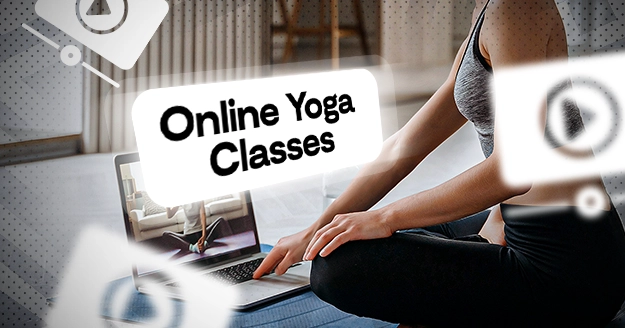In our tech-savvy world, the traditional boundaries of fitness and wellness are changing. One big change is the surge in popularity of online yoga classes. Thanks to the internet, you can now easily get into yoga without leaving your home.
Let’s explore why online yoga classes are becoming so popular and how they’re changing the way we think about staying healthy.
Benefits of online yoga class
-
Do yoga anytime, anywhere, and wear whatever you want.
The convenience and flexibility that come with taking yoga courses online are among its main benefits. Just imagine waking up, spreading out your mat in the living room, and doing Yoga in your pajamas. You can work out whenever it’s convenient without having to worry about traveling to and from the gym.
The days of squeezing into a studio after work or battling traffic to get to an early session are long gone. You can practice yoga wherever and whenever it suits you with online classes.
This degree of ease allows you to establish a regular routine, strengthening your body with yoga and enjoying its advantages in the process.
-
You can learn from the best teachers.
Online yoga brings some of the best teachers right to your screen. No matter where you are, you can easily have access to top rated online yoga classes and learn from top-notch experts in the comfort of your own space.
-
Customizing your yoga experience is easier.
In a typical yoga class, it might be difficult for teachers to provide each student with the one-on-one attention they need. On the other hand, yoga sessions offered online offer an immersive environment where students can customize their practice to meet their own goals.
Good online yoga courses let you customize your practice to meet your personal needs, whether you’re healing from an injury, pursuing a particular fitness goal, or just want to try out other techniques.
Many online platforms offer search functions and filters that let you locate classes that focus on different yoga styles, target particular body parts, or accommodate varying skill levels. This degree of personalization guarantees that you can design a yoga practice that feeds your body, mind, and spirit.
-
Online yoga is more affordable
Online yoga is often more affordable compared to traditional in-person classes.
The absence of costs associated with physical studio spaces allows for lower fees, making it a budget-friendly option for participants.
With various subscription plans and flexible pricing structures, online platforms offer affordability and accessibility, encouraging a broader audience to integrate yoga into their routines without financial constraints. This shift in cost dynamics is a key factor in the rising popularity of online yoga, making the practice more inclusive and adaptable to different budgets.
-
Building online communities
The absence of a sense of community is one of the issues that many have with online yoga courses. It is hard to recreate the sense of support and camaraderie that comes from practicing with other yogis (practitioners of yoga) in a class. Online platforms, however, have made a solution to this and developed creative strategies for promoting community interaction in the digital sphere.
One strategy is to offer live classes, which enable yogis to connect in real time with the instructor and other participants. This fosters a feeling of community among like-minded people who can encourage and support one another as they pursue yoga and develop a sense of shared experience. Furthermore, yogis can interact, discuss their progress, and ask peers and instructors for advice through social media groups, virtual courses, and forums
Disadvantages of online yoga class
-
Accountability issue
Participating in online yoga classes can sometimes pose challenges when it comes to accountability.
Unlike in-person classes, where the physical presence of an instructor and fellow participants helps maintain focus, the virtual setting can make it easier to get distracted or skip sessions. Without a direct, in-person connection, some individuals may find it challenging to stay motivated and accountable to their practice.
To address this issue, it’s essential for participants to establish a consistent routine, set personal goals, and leverage any accountability features offered by the online platform, such as progress tracking or community support.
Additionally, communicating with the instructor and creating a dedicated, distraction-free space for practice can contribute to a more accountable and rewarding online yoga experience.
-
Lack of quality control
The absence of direct oversight may result in variations in class quality, making it challenging for you to gauge the credibility and effectiveness of different sessions.
With a multitude of platforms and instructors offering classes, ensuring a consistent standard of teaching and practice can be difficult. Not to mention, anyone can publish a lesson on the internet, even though the majority of studios require teachers to hold a recognized training qualification.
You can seek out reputable platforms with established reviews and ratings, consider instructors with recognized certifications, and explore trial classes before committing to a particular online yoga program.
Additionally, feedback and communication with instructors can play a crucial role in maintaining a certain level of quality in the virtual yoga learning experience.
-
Technical issues
Practicing yoga online relies heavily on technology, and technical issues can be a significant drawback. Connectivity problems, audio glitches, or video lags can disrupt the flow of a session, impacting the overall experience. These issues may stem from internet instability, server problems on the platform, or device malfunctions. The frustration caused by such technical challenges can hinder the focus and enjoyment of the practice.
-
Distractions at home
Household chores, family members, or electronic notifications can divert attention and disrupt the meditative atmosphere that is crucial for effective online classes yoga. Unlike a dedicated studio space, home environments may not always provide the serene and focused setting that is conducive to a mindful yoga experience. Managing these distractions becomes a personal responsibility that practitioners must navigate when opting for online classes.
It’s important to note that the disadvantages mentioned can vary based on personal preferences, experience levels, and the specific online platform used. Despite these challenges, many individuals find online yoga classes to be a valuable and convenient resource for maintaining their yoga practice.










